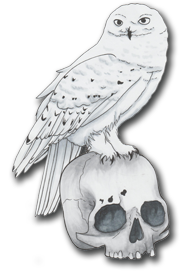Leather Masks
Lord Ihone Munro, AS XLIX
Project Completed December, 2014
Inspiration
My primary inspiration for creating these masks came from the Commedia dell'arte style, a 16th century improvisational theater method that was based predominantly around sketch comedy. I enjoyed looking through paintings of the period and seeing the various grotesques that were utilized, noting the pronounced features and how closely the nasals resembled a more human variant of a plague mask. Zanni, a stock trickster character, in particular called to me with his pronounced nose and sometimes goatee style beard. I see him as a rather dark character, so I decided to create a somewhat stylized Harlequin mask as well in order to be able to present a duality in styles at the same time as making the Zanni mask, since the character was quite beautiful in comparison with the diamond pattern in counter contrasting colors.
 Methodologies
Methodologies
Though the styles differ in end result, the method for making these masks was relatively similar. For the Harlequin mask, I wanted to give a little more definition to the line work, so I traced my pattern onto the leather and made a series of swivel knife cuts, then bevelled the lines to give a solid flow. To make the filigree areas stand out even more, I undercut them using a razor knife, then pulled the leather back using a modelling spoon. This gave it a heavier three dimensional look and feel that I was going for around the edges. I then beveled the internal portions of the filligree.
To mold both masks, I soaked the leather down and hand formed the mask to a manequin head. The Harlequin mask was more subtly formed, accenting the nasal and occular shapes. For the Zanni mask, I pressed in the oculars and the bridge of the nasal piece, then pushed and pulled against the nose portions to form the nostrils, then rolled the rest of the leather to form a more smooth finish to the nose itself. I then worked the length of the nose into a gradual slope to make it less abrupt and gain more definition.
The Harlequin piece was then base painted using a gold to give it a metallic look. Once the base paint had dried, I went over the diamond pattern with black and red alternatively and then finished with a black antique finish to accent the cut lines. The Zanni mask was finished using only an antique mahogany finish to give it a more devilish look that a trickster might have.
Build Notes
Steps in creating these particular pieces:
Step 1: For the Harlequin, the design was done in Photoshop first and printed. The lines are then traced out onto a piece of leather. For the Zanni, the basic shape of the mask was drawn out, then the nose freehand sketched onto the leather.

Step 2: The flat shapes are then cut out from 5oz leather.

Step 3: The lines are cut in with a swivel knife for the Harlequin. The edges along the filligree are recessed cut with a razor knife about ¼” into the surface of the leather and pulled back.
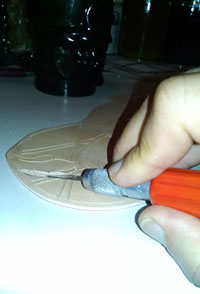
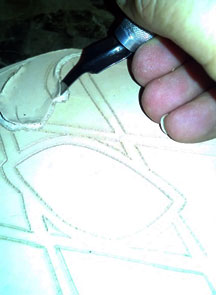
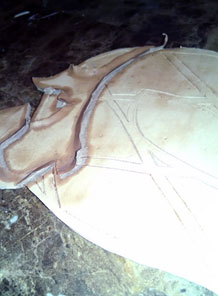
Step 4: The masks are both hand formed against the manequin head to get the dominant shapes in place with the brow, cheekbones, oculars and nasal areas.
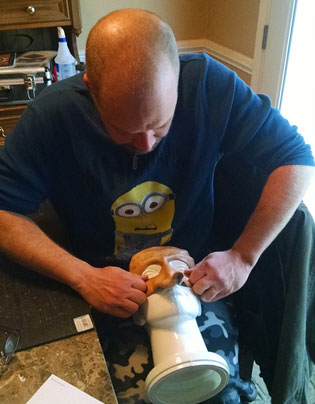
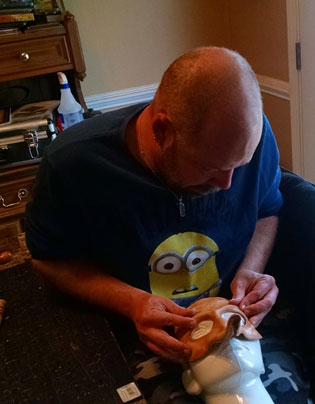
Step 5: Using a hand blow dryer, the masks are dried out. Using moderate heat helps to retain shape by somewhat hardening the leather. The fibers compress as the moisture leaves the leather itself with the heat. It’s a gentler hardening method than putting it in the oven, and is a much more targetted (though more time consuming) approach.
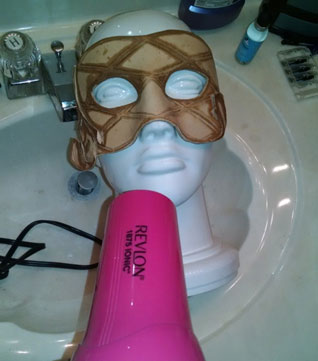
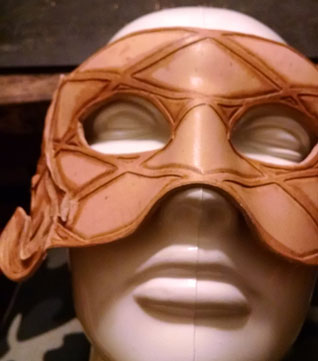
Step 6: The leather is painted using a series of water stains and antique finishes.

Constructive feedback is both welcome and appreciated, please let me know if I missed some pertinent information or if there's somewhere I can improve.
As always, thanks for reading!
Ihone
- A. Nicoll, The World of Harlequin (Cambridge, 1963)
- S. Rosenfeld, Foreign Theatrical Companies in Great Britain in the 17th. and 18th. Century (Londres, 1955)
